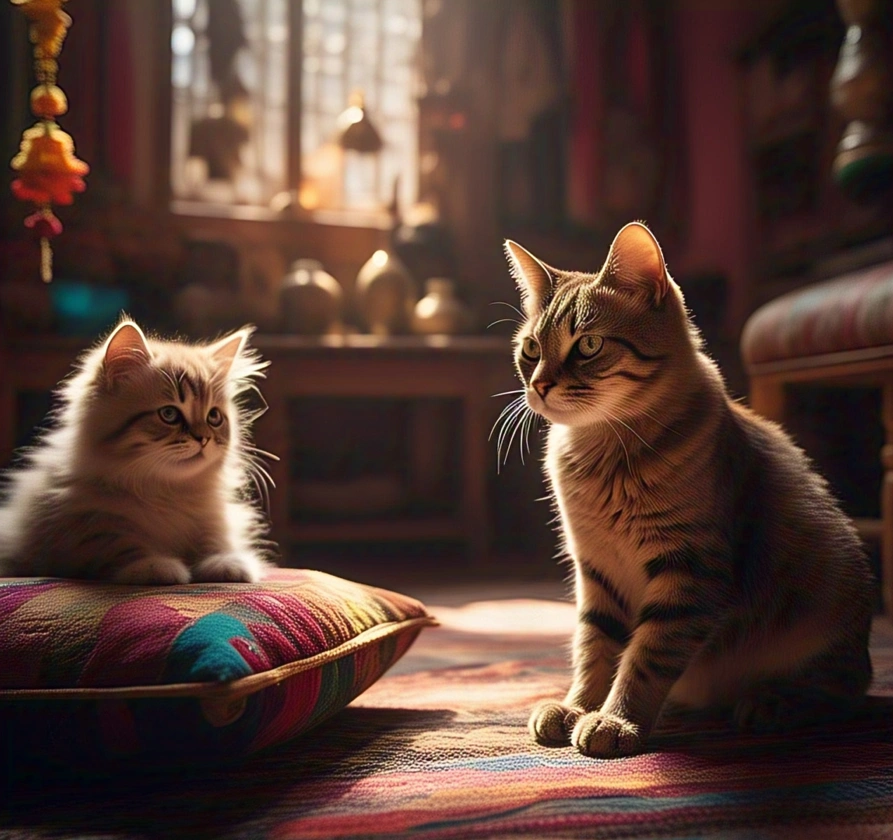Indian Cat vs Persian Cat: Pick Your Pet
Indian Cat vs Persian Cat: Compare traits, care, and suitability to pick the perfect pet for your Indian home.
Choosing between an Indian cat vs Persian cat is a pivotal decision for pet lovers. Each breed boasts unique traits, care requirements, and personalities, catering to diverse lifestyles. The Indian Street Cat, often called Billi or Spotted Cat, is a resilient native breed, while the Persian Cat, with its luxurious fur and calm demeanor, originates from Persia.
This comprehensive guide dives into their origins, appearance, behavior, and care needs to help you select the ideal feline companion for your Indian home.
Indian Street Cat vs Persian Cat: An Overview
To make an informed choice in the Indian cat vs Persian cat debate, understanding their backgrounds is essential. The Indian Street Cat, or Billi, is a native breed thriving in India’s bustling streets and rural areas, increasingly adopted as an indoor pet due to its hardy nature. In contrast, the Persian Cat, hailing from Persia (modern-day Iran), is a globally cherished breed known for its elegance and serene temperament. Both cats offer distinct qualities, making them suitable for different pet owners.
The Indian Street Cat’s adaptability to urban and rural habitats showcases its versatility, as noted by Supertails. Persian Cats, bred for indoor living, require pampered environments to thrive, according to Catster.
Appearance: How They Differ
A cat’s look often influences adoption decisions. Here’s how the Indian cat vs Persian cat compare in appearance and physique.
Indian Street Cat
The Indian Street Cat, also known as the Spotted Cat, sports a short, dense coat with rust or gray spotted patterns, ideal for minimal upkeep. Its muscular, athletic build and darker-tipped tail reflect a rugged charm, weighing 8–15 pounds. This native cat breed’s practical appearance suits India’s climate, requiring little grooming to maintain its sleek look.
Persian Cat
The Persian Cat dazzles with a long, silky, glossy coat in various shades, exuding a regal aura. Its compact build and signature flat face enhance its elegant feline appearance, with males weighing 8.8–13.9 pounds and females 7–11 pounds. However, this luxurious fur demands daily care to prevent tangles, as highlighted by Petfed.
Temperament and Personality
A cat’s behavior shapes its fit in your home. Here’s how the Indian cat vs Persian cat differ in temperament.
Indian Street Cat
The Indian Street Cat’s independent and adaptable nature stems from its street-dwelling roots. This feline temperament allows it to thrive in dynamic settings, and with early socialization, Billis become affectionate, loyal companions. Their resilience makes them ideal for households seeking a low-maintenance native cat breed that blends seamlessly into varied lifestyles.
Persian Cat
Persian Cats are renowned for their tranquil, gentle, and relaxed demeanor, preferring quiet environments. Their affectionate cat personality makes them perfect for families or individuals craving a calm companion. This serene temperament, as noted in Supertails’ breed guide, ensures they bond closely with owners in peaceful homes.
Care Needs: Grooming and Health
Care demands are critical when weighing an Indian cat vs Persian cat. Here’s a breakdown of their grooming and health requirements.
Grooming
The Indian Street Cat’s short coat simplifies feline grooming, needing only occasional brushing to stay sleek. This low-maintenance trait suits busy owners or those new to pet care. Conversely, the Persian Cat’s long, plush fur requires daily brushing to prevent matting, often necessitating professional grooming, which increases upkeep efforts.
Health Considerations
Indian Street Cats, when living on streets, may face risks like parasites, but as indoor pets, they’re robust with routine feline health care, including vaccinations and spaying/neutering. Indoor Billis can live 15–18 years. Persian Cats, however, are prone to respiratory issues due to their flat face, eye infections, and dental problems, requiring frequent vet visits. Their lifespan typically spans 12–17 years.
For expert pet care tips, explore PetMD to keep your cat thriving.
Climate Suitability in India
India’s hot, humid climate impacts a cat’s comfort. The Indian Street Cat’s short coat makes it a natural fit for Indian weather, effortlessly handling heat and humidity. This climate adaptability ensures Billis thrive without extra care. Persian Cats, with their thick fur, may struggle in humid conditions unless regularly groomed and kept in cool, air-conditioned spaces, as advised by Supertails.
Which Cat Fits Your Lifestyle?
Selecting between an Indian cat vs Persian cat depends on your lifestyle and home environment.
Indian Street Cat
- Pros: Low-maintenance, climate-resilient, budget-friendly, and sturdy. Ideal for busy households or first-time owners seeking a native cat breed.
- Cons: Street-adopted cats may need socialization to adjust indoors.
- Best For: Indian homes wanting a durable, independent pet.
Adopting a Billi supports efforts to reduce stray populations, as noted by Catster.
Persian Cat
- Pros: Loving, calm, and visually stunning. Perfect for serene, family-oriented homes.
- Cons: High grooming and health demands, less suited to humid climates without care.
- Best For: Owners with time for dedicated feline maintenance.
For adoption tips, check ASPCA’s pet guide.
Detailed Characteristics
Below is a detailed comparison table summarizing the key attributes of both cats, followed by an in-depth discussion.
| Aspect | Indian Street Cat (Billi) | Persian Cat |
|---|---|---|
| Origin | Native to India, commonly street-dwelling | Originates from Persia (modern-day Iran) |
| Typical Habitat | Streets, increasingly indoor pets | Primarily indoor pets |
| Coat | Short, dense, rust or gray with spots | Long, thick, glossy, various colors |
| Size and Weight | 8–15 pounds (3.6–6.8 kg), muscular build | Males: 8.8–13.9 pounds (4–6.3 kg), females: 7–11 pounds (3.2–5 kg) |
| Lifespan | 2–10 years on street, 15–18 years as indoor pet | Typically 12–17 years, may be shorter due to health issues |
| Temperament | Likely independent, adaptable; varies with upbringing | Calm, gentle, low-energy, suitable for families |
| Grooming Needs | Low maintenance, minimal grooming required | High maintenance, daily grooming to prevent matting |
| Health Concerns | May have issues on street (parasites, injuries); healthy as pets with care | Prone to respiratory problems, eye conditions, dental issues |
| Climate Adaptability | Well-suited to Indian climate, thrives in humidity | Can withstand heat with grooming, less adapted to humidity |
| Suitability as Pets | Low-maintenance, good for Indian households | Requires significant care, better for cooler climates |
FAQs: Indian Cat vs Persian Cat

1. Which cat is better for novice pet owners?
The Indian Street Cat is easier for beginners due to its minimal care and adaptable feline temperament. Persian Cats require more effort with grooming and health.
2. Can Persian Cats thrive in India’s climate?
With regular grooming and a cool environment, Persian Cats can adapt, but Indian Street Cats are naturally suited to Indian weather conditions.
3. How much grooming does an Indian Street Cat need?
Minimal feline grooming—brushing once or twice weekly—keeps their short coat healthy.
4. What health concerns affect Persian Cats?
Persians face respiratory issues, eye infections, and dental problems, needing consistent feline health care.
5. Are Indian Street Cats good indoor pets?
Yes, with socialization and care, Indian Street Cats make affectionate indoor companions, often living long, healthy lives.
Conclusion: Your Ideal Feline Companion
The Indian cat vs Persian cat choice hinges on your preferences and resources. The Indian Street Cat, with its rugged appeal and easy-care nature, is perfect for those seeking a climate-friendly, low-maintenance native cat breed in India. The Persian Cat, with its elegant looks and soothing presence, suits owners ready to invest in grooming and health care for a luxurious pet.
For more pet insights, visit Supertails or Catster. Which feline will win your heart?


